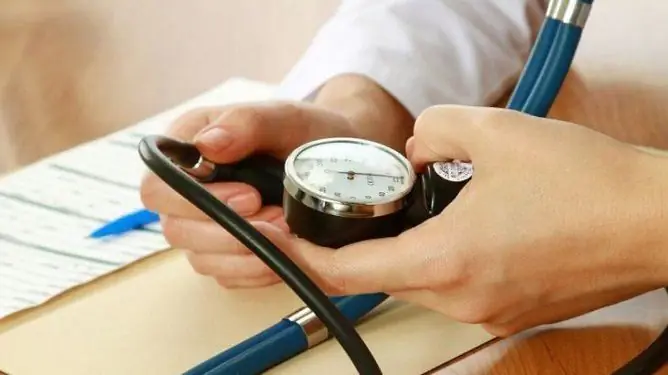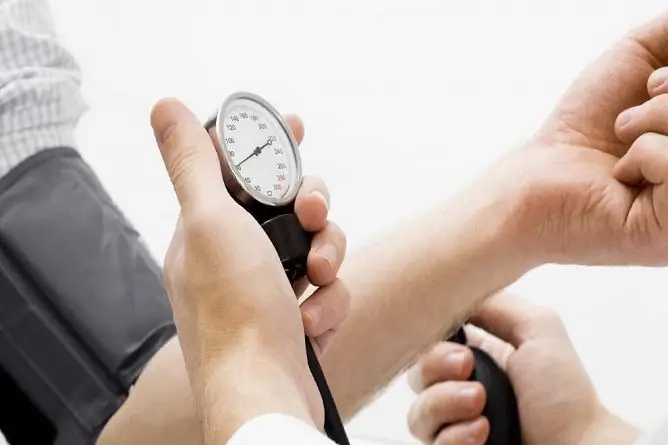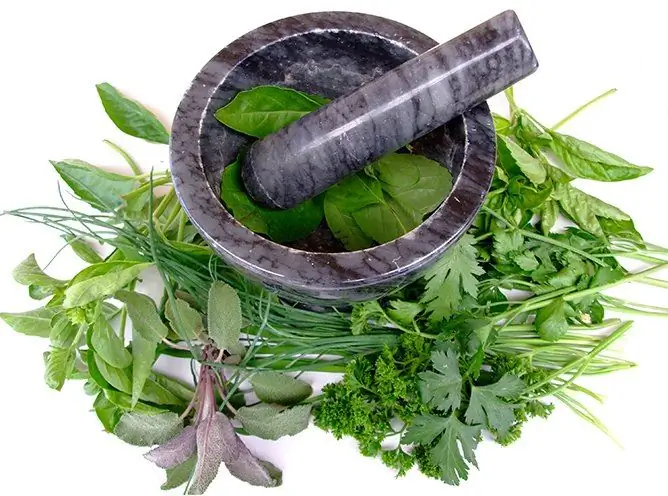- Author Rachel Wainwright [email protected].
- Public 2023-12-15 07:39.
- Last modified 2025-11-02 20:14.
How to lower your lower blood pressure: lower only the diastolic or both
The content of the article:
- How to bring down the bottom pressure
- How to reduce lower pressure with folk remedies
- Causes and risk factors for a decrease in diastolic pressure
- Overview of Elevated Diastolic Pressure
- Video
How to lower your low blood pressure at home? At the initial stages of pathology, it is possible to reduce the level of diastolic pressure without medication with the help of diet, lifestyle correction, physiotherapy exercises and rejection of bad habits. However, it is impossible to determine the type of pathology, as well as its stage, at home. Therefore, if this condition occurs frequently, it is necessary to undergo a medical examination and find out the exact diagnosis.
As for medications, self-medication with increased lower pressure is strongly discouraged; before using any treatment methods and medications, you should consult your doctor.

Before lowering diastolic pressure, it is necessary to find out the reason for its increase.
It is possible to reduce only the lower pressure, without lowering the upper one, at normal values of the systolic pressure. However, with an increase in the lower one, the upper pressure also rises. In such cases, both indicators should be reduced.
How to bring down the bottom pressure
Medicines are prescribed to quickly reduce blood pressure. Which drugs should be used depends on the cause of the pathology and its type.
Lower blood pressure can be lowered with the help of angiotensin-converting enzyme inhibitors, angiotensin 2 receptor blockers, beta-blockers, diuretics, antispasmodics, vitamin-mineral complexes. In some cases, the patient is shown a lifelong intake of the pills prescribed by the doctor.
To normalize diastolic blood pressure, which is outside the normal range, you should limit salt intake. Fatty and fried foods are excluded from the diet. To improve the condition of blood vessels, it is recommended to eat more foods rich in magnesium, potassium and B vitamins. Large amounts of potassium are found in potatoes, cabbage, tomatoes, peppers, cucumbers, radishes, beets, melons, watermelons, oranges, bananas, dried fruits and nuts. Foods rich in magnesium include beans, soybeans, millet, buckwheat, cottage cheese, sour cream, raspberries, strawberries, apricots. B vitamins are found in pork liver and kidneys, beef, rabbit meat, pears, cherries, apples, carrots. Vegetable juices (from cucumber, carrots, beets), garlic, onions, kombucha, persimmon, lemon contribute to lowering blood pressure.
Patients with high diastolic pressure need sufficient night sleep, adequate work and rest regimen, avoidance of stress and physical overload, and maintenance of normal weight.
How to reduce lower pressure with folk remedies
The most effective folk remedies for high lower pressure include hawthorn preparations - tincture or water infusion. To prepare a hawthorn tincture, a glass of fruits is crushed to a mushy state, poured with a glass of 70% alcohol, hermetically closed and left for three weeks in a cool dark place, shaking occasionally. Strain the finished product and take 30 drops in 1/3 cup of water. To prepare an infusion of hawthorn fruits, pour a tablespoon of fruits with a glass of boiling water, leave for 30 minutes and filter. The infusion is taken in a glass three times a day.
Valerian-based products are widely used in high diastolic blood pressure. To prepare the tincture, 2 tablespoons of the crushed root of the plant are poured with 10 tablespoons of alcohol, the container with the product is tightly closed and left in a dark, warm place for 2 weeks, after which the tincture should be filtered. The finished product is consumed in 20 drops per 30-50 ml of water three times a day. If you need to urgently reduce the diastolic pressure, you can take 30 drops of tincture. To prepare an infusion of valerian, you need to place 4 tablespoons of crushed plant roots in a thermos and pour 1 liter of boiling water. The tool is insisted in a closed thermos for 10-12 hours, filtered and taken 1.5 tablespoons three times a day.
Stevia extract is another effective remedy for hypertension. It can be added to drinks as it tastes sweet. To determine the dosage, you should consult with your doctor.
Flax seeds are used to improve the condition of blood vessels. To prepare the broth, 0.5 cups of seeds are thoroughly washed, poured in 0.5 liters of water, boiled in a water bath for 3 hours and allowed to cool. The remedy is taken in 1/3 cup 2 times a day (morning and evening).
Motherwort infusion will help with high lower pressure. For its preparation, a tablespoon of the herb should be poured with a glass of boiling water, leave for 30 minutes, drain. The resulting volume should be drunk 3-4 times, preferably in the afternoon.
To prepare an infusion of rose hips from high diastolic pressure, a tablespoon of dried fruits must be lowered into a thermos, pour 0.5 liters of boiling water and leave for 8-10 hours, then strain. The infusion is drunk, diluting to the concentration of weak tea, 2 times a day.
Before using folk remedies, it is advisable to consult a doctor.
Causes and risk factors for a decrease in diastolic pressure
The physiological reasons for the increase in diastolic pressure include physical activity, stressful situations. Risk factors for development are overweight, unhealthy diet, alcohol abuse, smoking, a sedentary lifestyle, excessive mental stress, pregnancy and menopause in women.

Hawthorn Tincture Helps Reduce High Diastolic Pressure
An isolated increase in lower pressure can be observed with malignant neoplasms, heart defects, endocrine diseases, dehydration, as well as with excessive consumption of too salty food, chronic fatigue.
A high lower pressure with a normal or slightly increased upper pressure may indicate that the patient has kidney disease or abnormal blood vessels.
A systematic increase in diastolic pressure (if it is 100 or more) may indicate severe damage to the kidneys and / or cardiovascular system.
Overview of Elevated Diastolic Pressure
Diastolic (lower) pressure is the pressure that the blood puts on the walls of the blood vessels during relaxation of the heart muscle (diastole). The indicator depends on the tone of the blood vessels, it can increase with a decrease in their elasticity and / or spasm.
A blood pressure (BP) level of 120 to 80 mm Hg is considered normal. Art. (the first number is systolic and the second is diastolic). Normally, this indicator may slightly deviate up or down. A high diastolic pressure is considered to be greater than 90 mm Hg. Art.
If the patient has only elevated diastolic blood pressure, and systolic pressure is normal, this condition is called isolated diastolic hypertension. This pathology is most often observed in patients over 60 years old, regardless of gender. With an increase in systolic and diastolic pressure, the pathology is called systolic-diastolic hypertension.
Increased lower pressure may not have clinical manifestations for a long time, in which case it is diagnosed accidentally during examination for another reason. This condition is manifested by a feeling of discomfort in the region of the heart, increased anxiety, accelerated heart rate, headache, weakness, tinnitus.
Both low and high blood pressure are pathological conditions and require correction. Increased diastolic pressure can lead to the development of coronary heart disease, myocardial infarction, heart failure, stroke, and other complications.
Video
We offer for viewing a video on the topic of the article.

Anna Aksenova Medical journalist About the author
Education: 2004-2007 "First Kiev Medical College" specialty "Laboratory Diagnostics".
Found a mistake in the text? Select it and press Ctrl + Enter.






